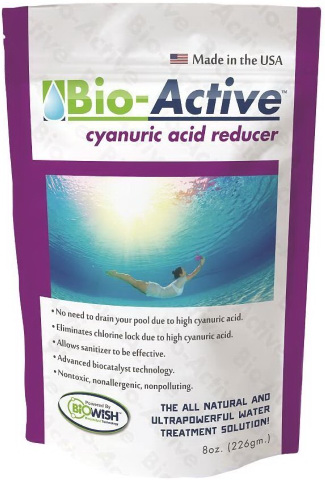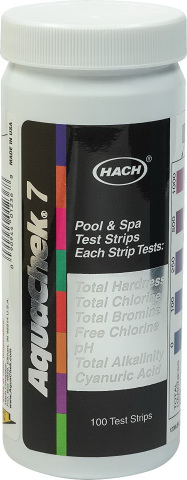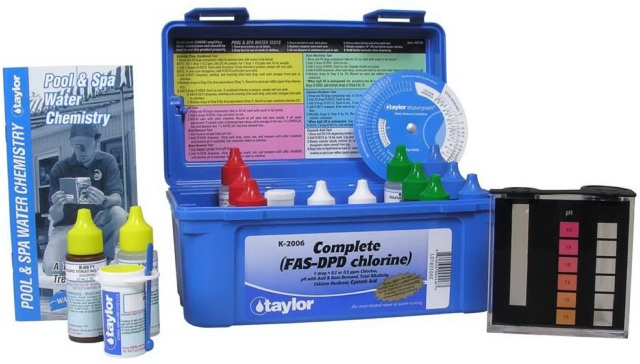In the past, high levels of cyanuric acid (stabilizer) in your swimming pool meant you would need to drain it to lower the levels. Not only is draining and refilling time-consuming, but it’s expensive too. Worry no more, improvements in water technology are changing the game.
Getting a cyanuric acid reducer may become your new best friend so read on to see if they work…
Cyanuric acid reducers work for approximately 66% of pool owners who have purchased them on Amazon. About 34% of users report that the product didn’t work, however, this is likely to be lower as there are some user error factors to consider.
How well cyanuric acid reducers work depends on a few conditions, so let me guide you on bringing your pool back to its happy and healthy self. Firstly…
Article Contents
What is Cyanuric Acid and Why is Its Level Important?
Cyanuric acid (CYA) is the key ingredient of stabilized chlorine. It enables chlorine to last longer in your pool, therefore prolonging the sanitization effect. Whilst chlorine breaks down naturally, CYA does not break down at all.
Without careful monitoring and using the correct chlorine choice, cyanuric acid levels can increase beyond acceptable levels.
As cyanuric acid increases, the efficacy of chlorine decreases. Maintaining an optimal balance between the two is crucial for a clean and healthy pool.
The World Health Organization (WHO) recommends cyanuric acid levels to remain below 100ppm, with an ideal range being 30-50ppm. Too low levels result in chlorine evaporating quickly. Too high levels reduce the chlorine’s ability to keep the pool clean of algae and bacteria.
Related Reading: Is Muriatic Acid the Same as Cyanuric Acid? What’s the Difference?
How Do Cyanuric Acid Reducers work?
Even though chlorine can evaporate rapidly, cyanuric does not naturally break down.
Without getting too science-y, CYA reducers bind to the cyanuric acid at a molecular level, breaking them down into end products like carbon dioxide, nitrogen gas, and water. These products are harmless to you and the environment, so it’s a win-win for all.
Even though CYA reducers work to normalize the levels of cyanuric acid, it doesn’t strip the pool of its entire supply of chlorine, so that’s one thing less to worry about.
How to Reduce Cyanuric Acid (stabilizer) Levels?
First things first, you’ll need to test your water. There are several ways to monitor your pool’s cyanuric acid levels including, pool test kits, or bringing a sample down to your local pool testing center. (Side note, most tests don’t register CYA past 100 ppm, so multiple tests may be needed to notice the CYA decrease after using a reducer).
Switching to unstabilized chlorine (doesn’t contain cyanuric acid) will help reduce CYA levels. Over time with the help of evaporation and topping up of pool water, the CYA levels will fall. When they are back in the normal range of 30-50 ppm, you can switch back to stabilized chlorine.
This can however take months.
A faster way to reduce levels is to partially drain your pool. That’s a lot of money and energy, right? Plus, it may not be possible because of local drought/water restrictions.
Further Reading: How to Lower Cyanuric Acid/Stabilizer in Pool (Cyanuric Acid Too High)
Until recently, these were the only options. So, what are your options today?…
Reducing Cyanuric Acid Without Draining
The world’s first CYA reducer out right now is the Bio-Active Cyanuric Acid Reducer. The company claims it’s proven to reduce cyanuric acid levels by 50% and is biologically based, so no harmful emissions or environmental effects.
Bio-Active Cyanuric Acid Reducer

Do Cyanuric Acid Reducers Work?
For the majority of people, cyanuric acid reducers do work as advertised.
As with most products on the market, there are mixed reviews as to if this product works or not. I researched the product extensively and found that in some cases the product worked as advertised and in other cases, pool owners reported it did not.
After further research, I found three common errors in the use of the product:
1. Inadequate Test Kit
2. Chlorine Levels too High
3. Not Enough Time
Inadequate Test Kit
As mentioned earlier, if your cyanuric acid level is over 100 -150 ppm, many test kits will not measure this high level of CYA (stabilizer). In practical terms, that means if you do add a cyanuric acid reducer it may seem like the product isn’t working when, in actual fact, the CYA levels are outside the limits of the test kit and therefore any changes are not seen when you test the water.
The solution is to get a test kit capable of measuring CYA at 300 ppm or more.
Or, failing that, you can measure high CYA levels using a dilution method. That is, dilute a sample of pool water by a known percentage, let’s say 1 part pool water and 1 part tap water, test this water, then double the test results to get your reading.
You could also dilute, so you have 1 part pool water and 2 parts tap water, then you’d multiply your test results by 3 to get the true reading.
e.g. if the results were 100 ppm, at this dilution level, the true CYA levels would be 300 ppm (3 x 100ppm).
Chlorine Levels too High
Many users found that it is essential to keep chlorine levels as low as possible. Since Bio-active is an organic based product, chlorine will do what it is supposed to do and destroy the bacteria in the product, reducing its effectiveness.
It’s suggested that you keep your chlorine levels at 1 ppm whilst using this product. Some users have reduced chlorine even further, however, they usually end up with algae issues afterward.
Not Enough Time
The product takes 7-10 days to work fully. Some users have been impatient and have reported this product not to work because they simply didn’t wait long enough.
Cyanuric Acid Reducers Side Effects
The manufacturer of Bio-Active Cyanuric Acid Reducer reports there are no side effects. But what do real users say?
In some cases, users of this product claim they have been left with huge chlorine demands. Meaning that they have had to use huge amounts of chlorine to stabilize the chlorine levels and bring them back to normal.
The jury is out on this one. There is no independent proof to say the product can cause this. It could be the user simply had high levels of organic matter, like algae, in their water which would cause high chlorine demand.
How to Use Cyanuric Acid Reducers
Before using Bio-Active Cyanuric Acid Reducer, it’s important to have your pool in prime condition. To achieve the best results, make sure your pool water is between 65° – 140° Fahrenheit with chlorine at 5 ppm or less (ideally 1 ppm).
It’s also important to test your pool’s water chemistry and make adjustments before you start the treatment. You can use a strip test kit like this one:

Click here to check the price >>
Or a quality drop test kit like this one:

Click here to check the price>>
In each case, if your CYA readings are about 100 ppm, it’s recommended you perform another test using a dilution method to make sure you are not maxing out the test kit’s limits.
Keeping the chlorine in this range during the application, as well as for the following week, will give you the best chance of success. If the chlorine is at a higher level, it will attack the active ingredient in the CYA reducer.
You may need an additional dose of the product, after 7 days, if the CYA levels were particularly high.
If used correctly, Bio-Active Cyanuric Acid Reducer can bring your pool’s CYA levels down to 40-60ppm. Beats draining your pool for the same result, right?
Can I Overdose My Pool with Cyanuric Acid Reducers?
The natural ingredients of Bio-Active Cyanuric Acid Reducer mean no stress over overdosing. It’s not possible. The reducer will normalize the cyanuric acid levels and break down any excess, leaving no residue or effect on the pool’s water chemistry.
If your pool needs more than one dose (if your pool is more than 25,000 gallons) but two doses seem too much, have peace of mind that any excess Bio-Active Cyanuric Acid Reducer will self-degrade.
How Long Does It Take Cyanuric Acid Reducers to Work?
It can take between 7-10 days before you’ll see a decrease in cyanuric acid levels. If the level is well above 100ppm, you may need to apply a second dose after the 7-day mark. This is why knowing your starting measurements are essential to correctly monitor the reducer’s performance.
Side note: When re-testing your CYA levels, be mindful that there may be cyanuric acid residue in the test equipment.
A plaster pool can throw off your measurements, especially if it’s made from porous plaster. CYA can become trapped in the plaster, then release as the reducer works its magic, increasing the CYA levels.
In this case, it could take multiple treatments.
Related Reading: Cyanuric Acid for Pools – The Complete Guide for Pool Owners
Cyanuric Acid Reducers Costs
Bio-Active Cyanuric Acid Reducer comes in an 8oz pouch, retailing at less than $65 (Amazon). This pouch is perfect for pool sizes up to 25,000 gallons. Having the correct pool conditions before application, you’ll only need one pouch to fix that pesky stabilizer level (CYA).
You can check the current price here >>
Final Thoughts
Having to deal with high cyanuric acid levels in your pool is a pain and can ruin your day.
Partially draining your pool and switching to unstabilized chlorine is a tried and tested method for reducing CYA levels in your pool. That’s because it’s proven to work effectively with no side effects.
However, if you have water restrictions, a drought or don’t have the inclination to drain your pool, you could give Bio-Active Cyanuric Acid Reducer a go. For many pool owners, using a cyanuric acid reducer has worked well for them,
It’s up to you which method you use, but just don’t leave your cyanuric acid levels high.

